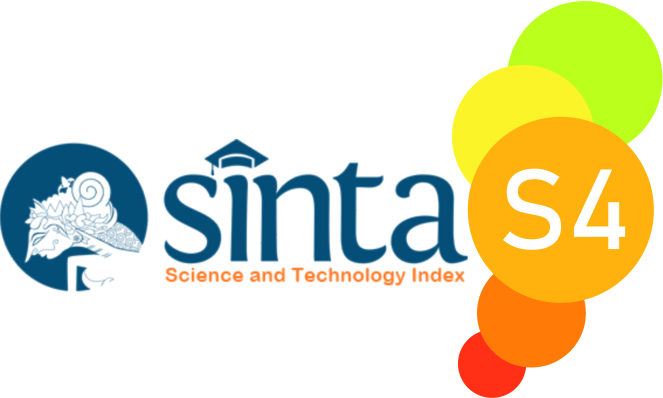Description of Characteristics of Participants in Class 3 in 1 Operators Yunior Custom Made Women in Balai Diklat Industries, Padang
 ), Alim Harun Pamungkas(2),
), Alim Harun Pamungkas(2), (1) Universitas Negeri Padang
(2) Universitas Negeri Padang
 Corresponding Author
Corresponding Author
DOI : https://doi.org/10.24036/spektrumpls.v8i1.107757
Full Text:
 Language : en
Language : en
Abstract
This research is motivated by the success of training participants in participating in training activities in the Padang Industrial Training Center. The researcher suspect that the high success achieved by the training participants is influenced by the good characteristics of the training participants in which the training participants’ interest and enthusiasm are said to be good. This can be seen from the characteristics of the participants in attending the training which consist of: cooperative type, passive type, and vandalizing type. This study aims to illustrate how the characteristics of the training participants as a benchmark for the education and training committee so that the training can be implemented well in the Padang Industrial Training Center. This type of research is quantitative descriptive research. The population in this study were participants of the 3 in 1 junior custome made female operator which amounts to 70 people. The sampling technique used was simple random sampling, in which the population in this study was 50% of the population of 35 people. Data collection techniques using a questionnaire in the form of a Likert Scale. While the data analysis technique uses the percentage formula. From the results of the study it was found that: (1) the cooperative type characteristics of the training participants were categorized as good, (2) the passive type characteristics of the training participants were categorized as less (3) the characteristics of the troubled type of the training participants were categorized as less. Based on the results of the study it is recommended that training participants can have better characters so that the training can run smoothly, and can have high motivation and good interest in participating in the training.
Keywords: Characteristics, Participants, Training, Custome Made
References
Aini, W. (2006). Bahan Ajar Konsep Pendidikan Luar Sekolah. Padang: FIP UNP.
Ginting, A. (2011). Esensi Praktis Manajemen Pendidikan dan Pelatihan. Bandung: Humaniora.
Gita, I. G. A. A. A. R., & Sariyath, N. K. (2016). Pengaruh Lingkungan Kerja, Self-Efficacy, dan Karakteristik Peserta Pelatihan terhadap Transfer Pelatihan pada Karyawan PT. Indonesia Power. E-Jurnal Manajemen Unud, 5(7), 4602–4629. Retrieved from https://media.neliti.com/media/publications/254139-pengaruh-lingkungan-kerja-self-efficacy-17fd9d1a.pdf
Gita, I., & Sariyathi, N. (2016). Pengaruh Lingkungan Kerja, Self-Efficacy, Dan Karakteristik Peserta Pelatihan Terhadap Transfer Pelatihan Pada Karyawan Pt. Indonesia Power. E-Jurnal Manajemen Universitas Udayana, 5(7), 4602–4629.
Jean, P., DWP, S., & Rusdarti, R. (2017). Model Pelatihan Vokasional Berbasis Pemanfaatan Rebung Bambu pada Masyarakat Desa Paloan Kecamatan Sengah Temila Kabupaten Landak. Journal of Vocational and Career Education, 2(1), 70–78. https://doi.org/10.15294/jvce.v2i1.11107
Mutiah, D. (2010). Psikologi Bermain Anak Usia Dini. jakarta: kencana.
Pamungkas, A. H. (2014). Pengelolaan Pelatihan dalam Organisasi (Tinjauan Teori Pembelajaran Orang Dewasa) (Makalah). Padang. Retrieved from http://www.sumbarprov.go.id/images/1450027790-2. alim harun.pdf
Pamungkas, A. H. (2019a). Management of Human Resources in Community Learning Center to Achieve the Objectives of Social Development Goals. Padang International Conference on Educational Management And Administration (PICEMA 2018), 337(Picema 2018), 233–235. https://doi.org/10.2991/picema-18.2019.48
Pamungkas, A. H. (2019b). The Approaches Used by Community Learning Center (PKBM) to Achieve Sustainable Development Goals in Solok Selatan West Sumatra Province Indonesia. In A. H. Pamungkas, S. Syuraini, & W. A. Wahyudi (Eds.), 1st Non Formal Education International Conference (NFEIC 2018) (Vol. 293, pp. 14–18). Paris: Atlantis Press. https://doi.org/10.2991/nfeic-18.2019.3
Pamungkas, A. H., Sunarti, V., & Wahyudi, W. A. (2018). Peran PKBM dalam Peningkatan Pertumbuhan Ekonomi dan Kesejahteraan Hidup Masyarakat Sesuai Target SDGs. SPEKTRUM: Jurnal Pendidikan Luar Sekolah (PLS), 1(3), 301–307. https://doi.org/10.24036/spektrumpls.v1i3.101240
Suci, Y. T., & Jamil, A. S. (2019). Hubungan Tingkat Kepuasan Pelayanan dengan Keberhasilan Peserta Pelatihan Teknis Bagi Penyuluh Pertanian. Jurnal Hexagro, 3(2), 47–55. https://doi.org/10.36423/hexagro.v3i2.279
Sudjana, D. (2001). Pendidikan Luar Sekolah. Bandung: Falah Production.
Ukkas, I. (2017). Pengembangan SDM Berbasis Pelatihan Keterampilan dan Pemberdayaan Pemuda. Prosiding Seminar Nasional, 3(1), 120–125. Retrieved from https://journal.uncp.ac.id/index.php/proceding/article/view/830/715
 Article Metrics
Article Metrics
 Abstract Views : 225 times
Abstract Views : 225 times
 PDF Downloaded : 91 times
PDF Downloaded : 91 times
Refbacks
- There are currently no refbacks.

This work is licensed under a Creative Commons Attribution-NonCommercial 4.0 International License.



